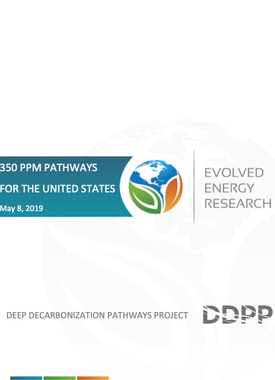
350 PPM Pathways for the United States
This report describes the changes in the U.S. energy system required to reduce carbon dioxide (CO2) emissions to a level consistent with returning atmospheric concentrations to 350 parts per million (350 ppm) in 2100, achieving net negative CO2 emissions by mid-century, and limiting end-of-century global warming to 1°C above pre-industrial levels. The main finding is that 350 ppm pathways that meet all current and forecast U.S. energy needs are technically feasible using existing technology, and that multiple alternative pathways can meet these objectives in the case of limits on some key decarbonization strategies. These pathways are economically viable, with a net increase in the cost of supplying and using energy equivalent to about 2% of GDP, up to a maximum of 3% of GDP, relative to the cost of a business-as-usual baseline. This work is the latest publication of the US Deep Decarbonization Pathways Project, led by Evolved Energy Research and US DDPP Director Jim Williams.
Downloads and Related Links